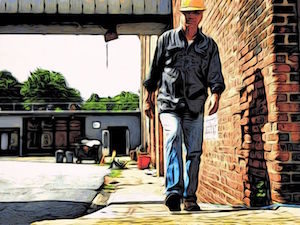
My good friend Jeff Mann, the true Yard Ramp Guy, has asked me to revisit some of my original posts. This week in my From the Archives series: alternative search engines. WolframAlpha'ing, anyone?
Q: What is the average weight of a panda?
A: 170-290 lbs.

Searching for Engines
There are a lot of different search engines out there, but most people never feel the need to go past Google. For the most part, I'm with them. I have discovered a few specialty search engines that I visit on a regular basis. Most of these are simply engines that search inside a specific website, usually Wikipedia. There are a couple exceptions, though. The biggest one is called WolframAlpha.
Q: How many people have the given name McCoy?
A: 1649 estimated to still be alive in the United States.
Strictly speaking, WolframAlpha isn't a search engine at all. It's a computational knowledge engine. Its creator, Stephen Wolfram, designed the engine to answer factual questions by using its curated internal database of information. This is a very different function than search engines, which provide a list of documents or web pages that might contain the answer.
Q: Motorcycle traffic in Germany?
A: 11.1 billion vehicle miles per year.
WolframAlpha can perform arithmetic, trigonometry, algebra, and numerous other mathematical functions. It contains population estimates from around the globe. It records weather data from the past in the database. And so this computational knowledge engine can use all of this information, along with its countless volumes of other information, to calculate the answers to a huge number of questions.
Q: Melting point of teflon?
A: 327 degrees Celsius. (620.6 degrees Fahrenheit)
Not to say that Wolfram Alpha is perfect. Its databases don't contain anywhere close to even a significant percentage of human knowledge. It doesn't know the average speed of a turtle, for instance, so you couldn't use it to figure out how long it would take one to cross the United States.

My own computational knowledge engine.
A fun Twitter account I ran into the other day is dedicated entirely to sharing odd questions that Wolfram Alpha can't answer. My personal favorites:
- “Hectares of cotton crops needed to make a superhero cape for every land mammal.”
- “Total work done against gravity to make a cupcake rise while baking it, in calories?”
- “Most common English misspelling that changes the word's Scrabble score by more than 4?”
And knowledge crawls onward…
Q: Anchorage, Alaska weather on 7/7/07?
A: Overcast, 54 to 61 degrees Fahrenheit, wind 0 to 7 mph.
Q: Most frequently erupting volcano?
A: Stromboli, in Italy.
Q: 20 gallons of gloss paint?
A: 14,000 square feet, assuming it has a spreading capacity of 690 square feet per gallon.
Q: How long did the Paleoproterozoic Era last?
A: 900 million years.
Q: x+y=10, x-y=4
A: x=7, y=3
Q: What's the temperature of the solar wind?
A: 31,000 Kelvin.
Yard Ramp Guy Blog: Inventory Management
Any time someone calls out the emperor's new clothes, I'm all in. This week, my friend The Yard Ramp Guy does just that, and then shows us how his business has been more efficient than a backordered cleaning cloth.
Click HERE to wipe the slate...cleaner.




 We’ve heard of the Stone Age, the Bronze Age, and the Iron Age. And yet, we aren't commonly taught why those ages occurred in that order. Which is just too bad, since it's pretty darn interesting.
We’ve heard of the Stone Age, the Bronze Age, and the Iron Age. And yet, we aren't commonly taught why those ages occurred in that order. Which is just too bad, since it's pretty darn interesting.

